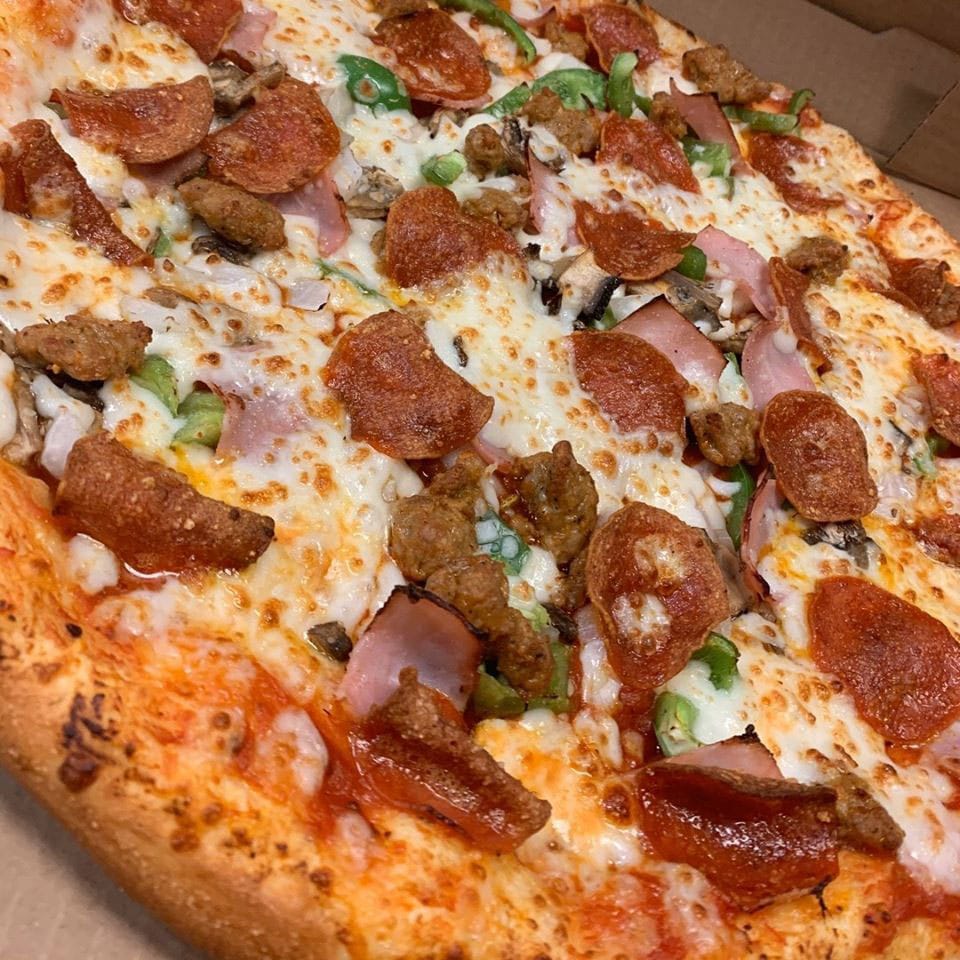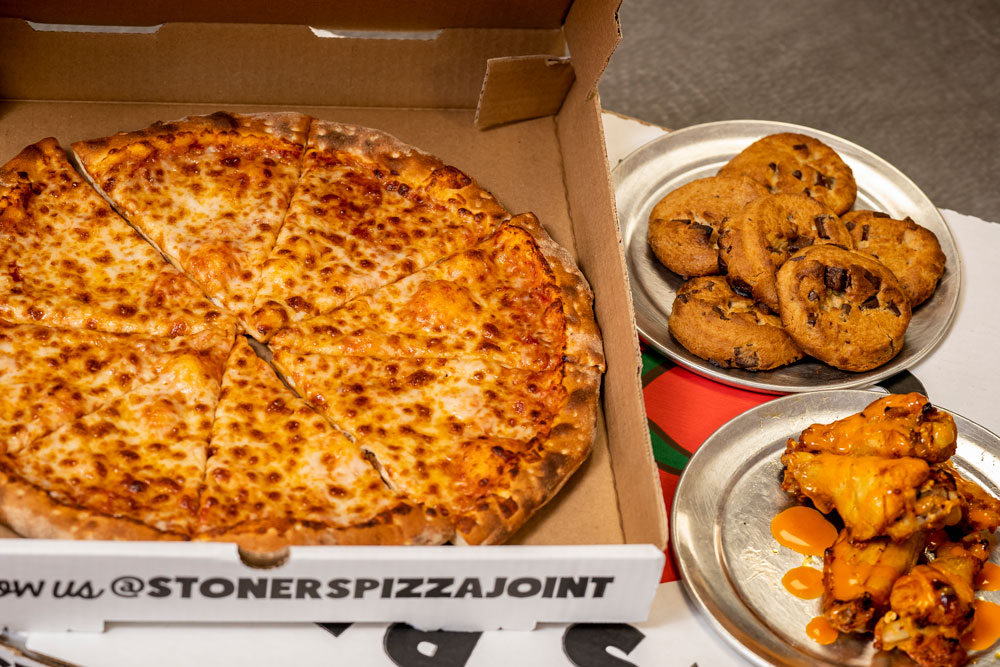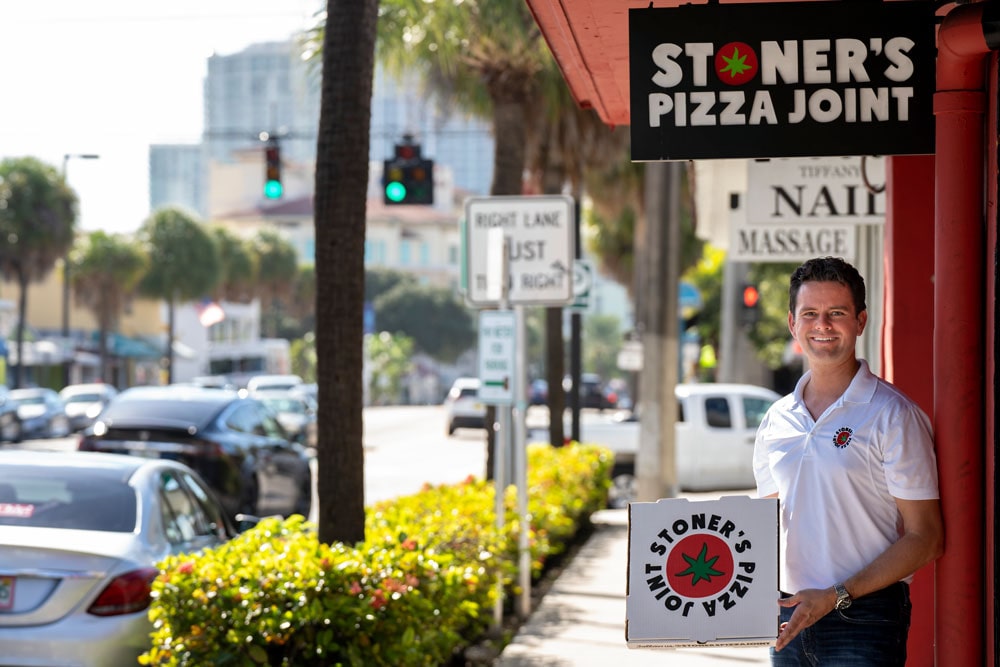By Rick Hynum | Photos provided by Stoner’s Pizza
Veteran pizzeria operators know their stuff, but some tend to get stuck in old habits or cling to outdated marketing strategies. That’s not a problem for John Stetson, CEO of Stoner’s Pizza Joint (SPJ) and owner of seven SPJ franchises in Florida, Georgia and South Carolina. The founder and managing member of Sunset Bay Capital, a private equity firm in Fort Lauderdale, Florida, Stetson is a latecomer to the pizza industry. But after years of guiding other companies through every stage of growth, from start-up to IPOs and mergers and acquisitions, he understands the core principles of business—and has proven to be a fast learner on the pizza side. So fast, in fact, that he took over the reins of SPJ as CEO in May 2020, not long after opening his first several stores.
Founded in 2013 and focused on the southeastern United States, Stoner’s Pizza Joint, headquartered in Fort Lauderdale, launched its franchising program in late 2018. Stetson knew a strong brand with growth potential when he saw it. The edgy name and brand theme resonate with the millennial and Gen Z crowd—and pretty much anyone who likes to smoke a little weed now and then, legally or otherwise.
It’s a brand custom-designed for college towns and any market where marijuana has been legalized. But after Stetson got his first SPJ stores up and running, the pandemic hit, dine-in lockdowns went into effect nationwide, and Stetson was confronted with challenges he never expected. He talked with us about how SPJ weathered the COVID-19 storm and shared his ideas for marketing a lesser-known pizza brand through both old-school and digital strategies.
“I don’t want to be that guy who’s sending 100 messages a week and pinging you all the time. It’s about marketing with a purpose. We send out a text or a push notification every two weeks.”
— John Stetson, Stoner’s Pizza Joint

SPJ’s signage lights up at night to draw attention to the store, while eye-popping colors and wallpaper create a sense of energy and fun for indoor diners.
PMQ: How did you end up becoming a Stoner’s Pizza Joint franchisee?
Stetson: Some co-investors in other business deals I’ve had made investments in Stoner’s on the corporate side. They started to educate me on the economics. I’d always been looking to get into being a franchisee. I looked at some of the bigger brands, like Dunkin Donuts or Jimmy John’s. They have unbelievable brand names, but the cost to get in is quite a bit. This one, to me, was fun. It was something new—you can call it “millennial,” but it doesn’t have to be millennial. And I can use the cannabis movement a little bit in my marketing, although we don’t ever want people to think there’s actually CBD or THC in our recipes.
Related video: John Stetson talks about effective communications during the pandemic
PMQ: So how did you make it through the pandemic while building up the Stoner’s brand?
Stetson: While many other restaurants here lost their dine-in service, they were scrambling to get delivery drivers, and some didn’t have Uber Eats, DoorDash and Postmates because so much of their business was dine-in. We were staffed up and actually hired a couple of new delivery drivers. We trained our staff on all of the safety and sanitization requirements. We designated a shift leader who is responsible for wiping down everything after each order and staying on top of employees washing their hands, and we put in a no-contact delivery system and curbside takeout. But 30% to 40% of our business was dine-in, so it was definitely a shift. We also waived our delivery fees and got aggressive with our specials. We added a large 14” one-topping special for $7.99. We definitely kicked up some specials to grow our customer base.

To help employees facing financial difficulties during COVID-19, John Stetson began providing them with full meals for every shift they worked.
PMQ: What steps did you take to help your community get through this difficult period?
Stetson: Shortly after the pandemic started, we made a pledge to donate 10,000 slices to the community in Fort Lauderdale. After speaking to a couple of our employees, as a father of two young ones myself, I saw this need. Schools were closing, and people were scrambling to figure out what they were going to do with their kids, not only for daycare but also for meals. The best way we could help the community was to provide these lunches to children in need and families that counted on school lunches as part of their everyday food for their children. We donated slices to community centers, churches and daycare facilities. And that, in turn, spurred a whole bunch of support from the community who wanted to help out. Seeing the smiles on the kids’ faces, eating a hot pizza and being with their family—you realize what that means to people.
PMQ: The pandemic was bad timing for everyone, but you were getting ready to open your fourth store at the time, right?
Stetson: We had two stores in Savannah, Georgia, and one in Fort Lauderdale, and I was opening a fourth in Warner Robins, Georgia. We were all set for our final health inspection and were targeting to open on April 1. This obviously put a halt to our plans. We had to hit pause and look at what kind of expenses we were taking on. It was also tourist season, so it was very, very tough timing. It was during the heart of Spring Break. We were gearing up for a big March Madness and St. Patrick’s Day. All of those are very, very big events that we were prepared for. We had to pivot and look for other ways to gain customers.
Related: John Stetson of Stoner’s Pizza Joint gives away free pizza for a pawsitive cause

Stoner’s Pizza Joint features a menu loaded with specialty pizzas in small, large and “really big” sizes.
PMQ: How did you do that?
Stetson: It goes back to trying to reach new audiences, and that meant getting aggressive with social media and running specials and trying to get in front of new people who hadn’t tried us before. We expanded our delivery range out one mile further, waived our delivery fees and used specials to get them in the door. Maybe we don’t make money that first time, but I’m betting my product is something they’ll come back for down the road.
My brand is obviously more of a millennial brand. So we already had a delivery app with loyalty points that allowed me to stay in front of our customers. We use push notifications with a text message or alert about our specials sent through the app. If you haven’t ordered from the app, you get 15 percent off. We have a loyalty rewards program—at 100 points, which is a handful of orders, you get a free small pizza or wings. But I don’t want to be that guy who’s sending 100 messages a week and pinging you all the time. It’s about marketing with a purpose. We send out a text or a push notification every two weeks. That’s something people will be interested in as opposed to being annoyed.
We also sent out our menus for delivery-carryout with the number right on front. The over-65s are old-school, so they pick up their phone and call your store. Some of them are not on social media or aware of these specials, so I still do the old-school advertising by mailing out our menus. We also put out signage in front of the store for curbside customers and used our app to let them know about that.

Stetson endeared himself to animal lovers by placing flyers on his pizza boxes that feature adoptable pets from a local Humane Society shelter and offering a free year of pizza to SPJ customers who adopt an animal.
PMQ: Speaking of social media, you work with a company called BaggottsBOTS, which specializes in chatbots, artificial intelligence (AI) and “conversational commerce.” How has that worked out for you?
Stetson: I’m currently using BaggottsBOTS in four of my locations—Midtown Savannah; Fort Lauderdale and Davie, Florida; and Columbia, South Carolina. Additional locations are testing it now. Working with BaggottsBOTS, we were able to launch contests to engage people on social media and connect them with our brand. We started with movie quizzes, then moved to a Wheel of Fortune game, where you spin the wheel to get a free item. Then it was a dodgeball game—you hit the guy, you get a free item. This got people engaged so they’d stay on our page for more than that split second it takes to look at your meme or a picture of your pizza. The goal is to make that person a customer who is ordering from you. You can go halfway by getting them to your Facebook page or website, but what do I want at the end of the day? I want them to order. I want to know who they are—their name, their phone number and what they like to eat—and I want to do that in the most efficient way possible. BaggottsBOTS lets customers place an order that goes directly from Facebook into my POS system. People are looking for the most efficient way to get what they want, and that’s why we’ve seen, in the last several years, the growth of apps. People are glued to their phones, and this is a really fast, efficient way to place an order.
Related: How the pandemic became the pizza industry’s finest hour
The ROI with chatbots has been tremendous. It has allowed me to communicate directly with the customer. Instead of just posting an ad or a meme, I’m engaging with the customer with our specific brand content. And instead of just having that one transaction, I’m now able to follow up with that customer and give them a targeted special. For instance, I know John always selects wings during our contests. I will be sending John all of our wing specials during our promotions. The future of marketing is through AI, and this funnel is exactly that: analytics that will help convert the click into an order.
“Working with BaggottsBOTS, we were able to launch contests to engage people on social media. We started with movie quizzes, then moved to a Wheel of Fortune game, where you spin the wheel to get a free item.”
— John Stetson, Stoner’s Pizza Joint
PMQ: But you still use old-school marketing strategies, too. Why?
Stetson: There are still people who look at the menus that come in their mailboxes. I do 2,500 to 5,000 menu drops each week. And I go to all the hotels, high-rises and businesses around us with free pizzas. I introduce myself to the concierge and the front desk manager. If a driver is taking a delivery to the 10th floor of a high-rise, I ask them to bring some extra menus. Maybe that customer’s neighbor wants pizza, too.
I also carry around these free pizza cards in my pocket. If I’m in line at the grocery store and see someone buying a frozen pizza, I hand them a card and ask if they’ve heard of Stoner’s Pizza Joint. I use car toppers, too. If you see one of our car toppers on the road, you’re gonna look at it. It’s a vibrant red color that stands out on a busy street.

PMQ: So what’s the future look like for Stoner’s Pizza Joint?
Stetson: Stoner’s was fortunate to grow significantly in the past year. Since I took over as CEO, the brand has grown from 10 units in April 2020 to 19 units as of March 2021. In addition, the company signed a 10-unit franchisee deal for central Florida and Kentucky.
In terms of non-digital marketing, we are still trying to be creative. Since we do not have a national presence, our focus is working inside out. For each new location, we approach the community as a new resident and neighbor. Our first mission is getting to know all the local organizations and businesses. We believe the community needs to get to know you first before trusting you as their go-to pizza joint. Through this methodology, we’ve been fortunate enough to partner with several nonprofit organizations, schools and hospitals to provide food for those in need. If you can show your support to your new community before asking for their support, you have a much better chance at success.
Our goal for 2021 is to grow with our existing franchisees, attract new franchisees and continue to build additional sales channels through our marketing efforts.
Rick Hynum is PMQ’s editor in chief. PMQ publisher Steve Green and U.S. Pizza Team coordinator Brian Hernandez contributed to this story.













